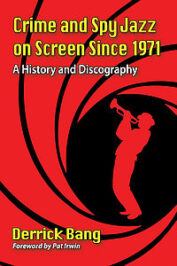In the second volume of his extensive study on crime and spy movie jazz, author Bang devotes his knowledge to the years 1971 to 2019.
His strategy of presenting these scores changes a bit in the present volume, as even though in the early 1970s movies were still shown in movie theaters almost exclusively, just as in the earlier decades, home entertainment, video rentals and cable TV would be well on their way only a decade later.
 However, in 1971, audiences would still watch several brilliant movies with equally superb jazz-flavored soundtracks, such as Dirty Harry, Shaft, and The French Connection (as well as the great Get Carter with unfortunately rather little jazz content). The late 70s also saw many blaxploitation productions with solid scores consisting of a blend of soul, funk and jazz.
However, in 1971, audiences would still watch several brilliant movies with equally superb jazz-flavored soundtracks, such as Dirty Harry, Shaft, and The French Connection (as well as the great Get Carter with unfortunately rather little jazz content). The late 70s also saw many blaxploitation productions with solid scores consisting of a blend of soul, funk and jazz.
In the 1980s, network television and cable TV completely changed the quantity and quality of what was consumable in terms of stories and soundtracks. This move to small-screen entertainment also meant more shows, more composers and more media to dig for. Bang accordingly organizes his individual chapters under the headlines “The Small Screen” and “The Big Screen.”
The style he is so fond of naturally also is the main player in this book, as it is a “…genre rich with heritage, confined mostly to a ‘golden era’ running from approximately the mid-50s to the mid-1980s. At its peak, action jazz was the go-to choice for crowd-pleasing films and TV-shows. Post-World War II generations who grew up with such stuff remember the music more than fondly; it often informs the soundtrack of their lives. Rock’n’roll may have ruled during the later 1960s, but action jazz aficionados from roughly the same period – a little before, to a little after – can argue just as persuasively about the lasting impact of their obsession.”
This book’s companion volume, Crime and Action Jazz on Screen: 1950-1970, covering the early years of the musical genre is also discussed here on popcultureshelf.com.
In the volume at hand, his emphasis again is on American movies and TV productions, but he includes quite a few titles from the UK and Western Europe. There are hundreds of quotes and interview parts from directors and composers who in a few sentences tell of their intention, available musicians and the kind of air they had in mind when directing or composing this movie or score.
It was to be expected that the author does not simply list composers (among them this time Mike Post, Mort Stevens, Dennis McCarthy, Laurie Johnson, Roy Ayers, Elmer Bernstein, Earle Hagen, Roy Budd, David Shire and others of the next generation), their influences, prior works and their reputation, together with individual musicians, recording studios and audio gimmicks (which already is more than one unusually gets from a book on soundtracks).
Instead, Bang also carefully compares their respective scores. This means he picks the title melody of a certain 1980s movie/show, which has some reminiscences to the underscore of, let’s say, an American show from 1961, while the main instrument in use there would be a specific Fender Rhodes, only that its sound is easily comparable to the title credits of, let’s say, an early 1970s English spy thriller, whose composer was that particular Italian musician…. This is very informative, unique and the way a collector would want a subject to be presented; just excellent.
Production-wise, musical style and content changed continuously over the years, and already in the late 1970s, the interest in and production of jazz-based soundtracks began to fade. Today, with all the self-produced channels and internet based high number of new shows intended strictly for TV audiences, available at any time via stream, the younger audience has grown up largely with different soundtracks and extra-diegetic audio, namely rock music, hip hop or all sorts of electronic sounds. (Nevertheless, online media and YouTube fortunately still provide access to classic TV shows).
Eventually, composing jazz scored for movies and TV became a niche product. And since the 1980s, TV shows, i.e. individual episodes, have been shortened, as for example in 2013, broadcast networks finally granted up to 15.5 minutes of ads during one hour of broadcast. Title credits, usually introducing each episode and running roughly 60 seconds – that once were important for the show’s identity and visibility – have been largely cut out.
However, there is some hope, if one is looking forward to listening to new jazz informed soundtracks, says Bang: “Although the current visual mediums remain indifferent – if not downright hostile – to orchestral sounds of any type, a few outliers remind us that jazz hasn’t vanished entirely. …. While we’re unlikely to enjoy another similarly bountiful era of combo and big band crime and action jazz, I’ve no doubt that a healthy number of contemporary film and TV score composers – with swing running through their blood – will do their best to honor the genre.”
Derrick Bang also hosts a blog concerned with the golden age of jazz soundtracks: www.screenactionjazz.com.
His second volume is equally worth reading and obviously owners of part one will want to find out what happened after the “to be continued” titles, concerning the adventures of the crime and spy jazz score.
Review by Dr. A. Ebert © 2020
Derrick Bang. Crime and Spy Jazz on Screen Since 1971: A History and Discography. McFarland, 2020, 240 p.
